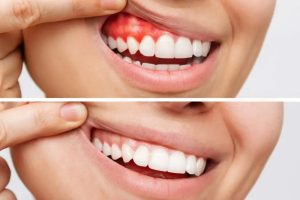 Periodontal disease, also known as gum disease, is a common condition that affects the gums, ligaments, and bone supporting the teeth. If left untreated, it can lead to tooth loss and have negative impacts on overall health. Thankfully, periodontists, who receive specialized training in treating gum disease, offer various treatment options. In this comprehensive guide, we will explore the different types of periodontal treatments and procedures available, including surgical and non-surgical treatments, dental implant procedures, and cosmetic procedures.
Periodontal disease, also known as gum disease, is a common condition that affects the gums, ligaments, and bone supporting the teeth. If left untreated, it can lead to tooth loss and have negative impacts on overall health. Thankfully, periodontists, who receive specialized training in treating gum disease, offer various treatment options. In this comprehensive guide, we will explore the different types of periodontal treatments and procedures available, including surgical and non-surgical treatments, dental implant procedures, and cosmetic procedures.
Understanding Periodontal Disease
Periodontal disease is a progressive bacterial infection that targets the gums, ligaments, and bone supporting the teeth. It is typically caused by poor oral hygiene, which allows harmful bacteria to accumulate in plaque and tartar. This buildup creates a film over the teeth, known as plaque, which can make the gums red, swollen, and tender. If not addressed, plaque hardens into tartar, which can only be removed professionally using specialized instruments.
The early stage of gum disease, known as gingivitis, is reversible with proper treatment. Regular visits to a periodontist are crucial for maintaining oral health and preventing gum disease from progressing to periodontal disease.
Surgical Treatment Options
Periodontists are trained in both surgical and non-surgical periodontal procedures. Surgical treatments are typically recommended for more advanced stages of gum disease or when non-surgical treatments have been ineffective. These procedures aim to remove plaque and tartar buildup, reduce pocket depths, and regenerate lost bone and tissue.
Flap Surgery (Pocket Reduction Surgery)
Flap surgery, also known as pocket reduction surgery, is a common surgical treatment for periodontal disease. During this procedure, the periodontist makes incisions in the gums to lift them and gain access to the tooth roots. This allows for thorough cleaning of the tooth surfaces, removal of plaque and tartar, reshaping of the underlying bone, and repositioning of the gums to reduce pocket depths. Flap surgery promotes better oral hygiene and facilitates the maintenance of healthy gum tissue.
Soft Tissue Grafts
When gum recession occurs due to periodontal disease, soft tissue grafts may be recommended to restore gum tissue and prevent further recession. During this procedure, the periodontist takes tissue from the roof of the mouth or a donor source and attaches it to the affected site. This helps cover exposed tooth roots, improve aesthetics, and reduce tooth sensitivity.
Bone Grafting
Bone grafting is a surgical procedure used to regenerate lost bone caused by periodontal disease. The periodontist places bone graft material (either synthetic or from another source) in the areas where bone loss has occurred. Over time, the graft material stimulates new bone growth, strengthening the jawbone and supporting the teeth.
Guided Tissue Regeneration
Guided tissue regeneration (GTR) is a surgical technique used to regenerate lost bone and periodontal ligaments. It involves placing a barrier membrane between the gum tissue and the tooth root to prevent the gum tissue from growing into the area where bone regeneration is desired. This allows the bone and ligaments to regenerate properly, restoring the health and stability of the tooth.
Non-Surgical Treatment Options
Non-surgical treatments are often the first line of defense against periodontal disease, particularly in the early stages. These treatments aim to remove plaque and tartar buildup, reduce inflammation, and promote gum healing.
Scaling and Root Planing
Scaling and root planing, also known as deep cleaning, is a common non-surgical treatment for gum disease. This procedure involves thoroughly cleaning the teeth and root surfaces to remove plaque, tartar, and bacteria. The periodontist uses specialized instruments to scale the tooth surfaces, removing buildup both above and below the gumline. Root planing smooths the root surfaces, making it more difficult for plaque and tartar to accumulate. Local anesthesia may be used to ensure patient comfort during the procedure.
Antibiotic Therapy
Antibiotics may be prescribed in conjunction with scaling and root planing or as a standalone treatment for gum disease. Topical antibiotics, such as antibiotic mouth rinses or gels, can be applied directly to the affected areas to control bacterial infection. In some cases, oral antibiotics may be prescribed to target bacteria causing infections deep within the gum pockets.
Laser Therapy
Laser therapy is a minimally invasive treatment option for periodontal disease. It involves using a dental laser to remove diseased gum tissue and bacteria. Laser therapy promotes gum healing, reduces pocket depths, and sterilizes the treated areas. This procedure is less invasive and may result in minimal discomfort and faster recovery compared to traditional surgical methods.
Maintenance Therapy
After undergoing periodontal treatment, maintenance therapy is crucial to prevent the recurrence of gum disease. Regular visits to the periodontist for professional cleanings, thorough examinations, and ongoing monitoring of gum health are essential for long-term success. The periodontist may recommend more frequent cleanings and tailored oral hygiene instructions to ensure optimal oral health.
Dental Implant Procedures
In cases where tooth loss has occurred due to advanced periodontal disease, dental implants may be recommended as a permanent replacement option. Dental implants are artificial tooth roots made of titanium that are surgically placed into the jawbone. They provide a stable foundation for the attachment of dental crowns, bridges, or dentures. Dental implant procedures are typically performed by periodontists or oral surgeons with expertise in implant dentistry.
The dental implant process involves several steps, including a comprehensive evaluation, surgical placement of the implant, a healing period to allow for osseointegration (the fusion of the implant with the jawbone), and the attachment of the final restoration. Dental implants offer a natural-looking and functional solution for replacing missing teeth, improving both oral health and overall quality of life.
Cosmetic Procedures
In addition to treating gum disease and replacing missing teeth, periodontists also offer cosmetic procedures to enhance the appearance of the smile. These procedures focus on improving the aesthetics of gum tissue, teeth alignment, and overall smile harmony.
Crown Lengthening
Crown lengthening is a cosmetic procedure that involves reshaping the gum tissue and bone to expose more of the tooth’s surface. It is often performed when there is excess gum tissue covering the teeth, making them appear shorter. Crown lengthening can create a more balanced and aesthetically pleasing smile.
Gum Recontouring
Gum recontouring, also known as gum reshaping, is a procedure that involves removing or reshaping excess gum tissue to create a more proportionate and symmetrical gumline. This procedure is commonly used to correct a “gummy smile” or uneven gumline, resulting in a more harmonious smile.
Ridge Augmentation
Ridge augmentation is a procedure used to restore the natural contours of the jawbone after tooth loss or bone resorption. It involves adding bone graft material to the deficient area to rebuild the ridge’s height and width. Ridge augmentation creates a solid foundation for dental implants and improves the aesthetics of the smile.
Gum Depigmentation
Gum depigmentation, also known as gum bleaching, is a cosmetic procedure used to lighten dark or discolored gums. It involves removing the excess melanin pigmentation to achieve a more uniform and aesthetically pleasing gum color.
Periodontal disease is a common condition that can have serious consequences if left untreated. Fortunately, periodontists offer a range of treatment options to address gum disease and restore oral health. Surgical treatments like flap surgery, soft tissue grafts, bone grafting, and guided tissue regeneration aim to repair and regenerate damaged tissues. Non-surgical treatments such as scaling and root planing, antibiotic therapy, and laser therapy can effectively manage early-stage gum disease. Dental implant procedures provide a permanent solution for tooth loss caused by advanced periodontal disease. Additionally, cosmetic procedures like crown lengthening, gum recontouring, ridge augmentation, and gum depigmentation can enhance the aesthetics of the smile. By seeking timely treatment from a periodontist and maintaining good oral hygiene, individuals can prevent the progression of gum disease and enjoy a healthy and beautiful smile.
Contact Us (859-586-7900) for more information!
—
 About Torbeck Dental
About Torbeck Dental
Torbeck Dental treats every patient with dignity and excellent care. We are highly trained dental professionals with exceptionally friendly and helpful service. We understand that for many, visiting a dentist can be a stressful experience so our comfortable surroundings and compassionate staff will ease any fears you may have. We are here to help you achieve your happiest and healthiest smile! Our dental team are a group of experienced professionals using the latest treatments. Our team has the professional experience to realize that there is no such thing as one-size-fits-all treatment, so we never use a one-size-fits-all approach to your dental plan. We provide quality and personalized oral health care while keeping your individuality in mind. Our goal is to improve and maintain your oral health so you can smile with confidence!
